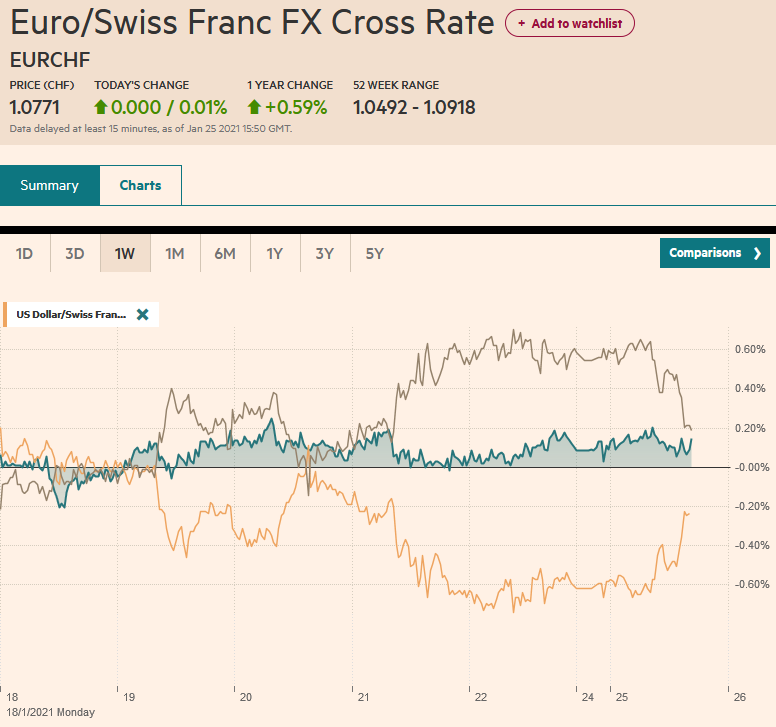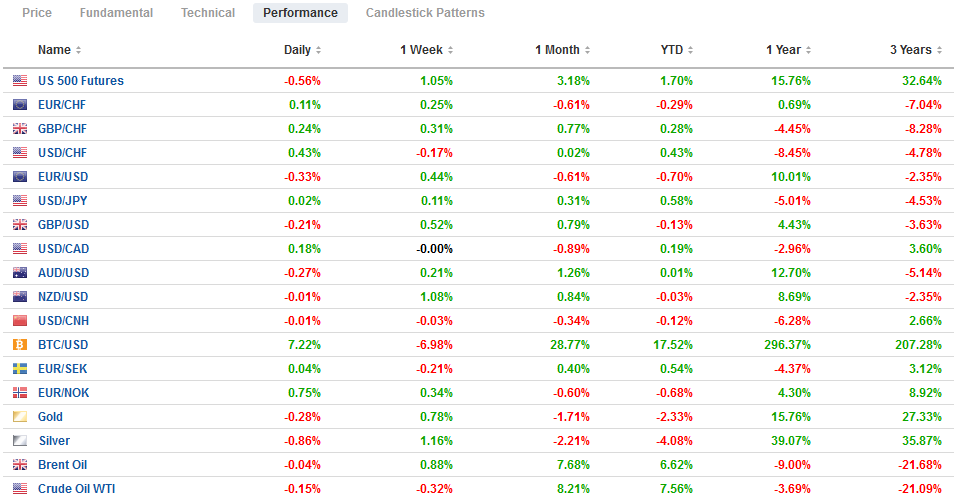Swiss Franc The Euro has risen by 0.01% to 1.0771 EUR/CHF and USD/CHF, January 25(see more posts on EUR/CHF, USD/CHF, ) Source: markets.ft.com - Click to enlarge FX Rates Overview: What promises to be an eventful week has begun off on a mostly subdued note. Asia Pacific equities moved higher, again led by Hong Kong and ostensibly mainland buying. The Hang Seng rose 2.4% to bring this year’s gain to 10.75%. South Korea’s Kospi also increased by more than 2%, and, so far this month, it is up almost 11.7%. Most bourses advanced, though Taiwan, India, and a few smaller markets declined. European shares are mixed. Energy, real estate, financials, and industrials are drags, while information technology, healthcare, and materials are moving higher. The Dow Jones
Topics:
Marc Chandler considers the following as important: 4.) Marc to Market, 4) FX Trends, China, Currency Movement, Featured, FOMC, newsletter, Scotland, Taiwan, U.K., USD
This could be interesting, too:
Nachrichten Ticker - www.finanzen.ch writes Die Performance der Kryptowährungen in KW 9: Das hat sich bei Bitcoin, Ether & Co. getan
Nachrichten Ticker - www.finanzen.ch writes Wer verbirgt sich hinter der Ethereum-Technologie?
Martin Hartmann writes Eine Analyse nach den Lehren von Milton Friedman
Marc Chandler writes March 2025 Monthly
Swiss FrancThe Euro has risen by 0.01% to 1.0771 |
EUR/CHF and USD/CHF, January 25(see more posts on EUR/CHF, USD/CHF, ) Source: markets.ft.com - Click to enlarge |
FX RatesOverview: What promises to be an eventful week has begun off on a mostly subdued note. Asia Pacific equities moved higher, again led by Hong Kong and ostensibly mainland buying. The Hang Seng rose 2.4% to bring this year’s gain to 10.75%. South Korea’s Kospi also increased by more than 2%, and, so far this month, it is up almost 11.7%. Most bourses advanced, though Taiwan, India, and a few smaller markets declined. European shares are mixed. Energy, real estate, financials, and industrials are drags, while information technology, healthcare, and materials are moving higher. The Dow Jones Stoxx 600 is up slightly and about 2.6% this month. US shares are trading higher, led by the NASDAQ (~5% this month), as several tech companies report earnings this week. Benchmark 10-year yields are softer, especially in the European periphery, led by a six basis point decline in Italian bonds, despite a key vote later this week. Other peripheral yields are off 3-4 bp, while the core is off two. The 10-year US benchmark yield is little changed, around 1.08%. The dollar is narrowly mixed, with the dollar-bloc and Scandis a little firmer and the other majors a little softer. The emerging market currencies are also narrowly mixed, leaving the JP Morgan Emerging Markets Currency Index slightly lower for the third consecutive session. Gold is firm and holding above the 200-day moving average (~$1848) that was violated last week. Crude oil is firm, and the March WTI contract is within the pre-weekend range. It is hovering around last week’s average close of around $52.80. |
Asia Pacific
An important battle is being waged in Australia. The Morrison government wants the digital platforms to pay media companies for their news content. Google and Facebook object. At the end of last week, Google was threatening to remove its search engine from Australia. Australia generates an estimated $4 bln of revenue for Google of its roughly $1.8 trillion in revenue. Apparently, it would walk away from the $4 bln to avoid setting a precedent. It is part of a broader re-examination of the power of digital platforms. It was seen recently too in the US when former President Trump was denied access to such platforms. If they are purely private companies, then a broader leeway must be allowed. Although I have had essays published in various papers, magazines, and journals. A notable exception is the Wall Street Journal, despite my best efforts. No one, not even my mother, would argue that my freedom of speech has been denied. However, the ubiquitous social media platforms appear to have taken on a public character, like utilities, gas, water, electricity, and therefore, the legal rights and responsibilities are still being negotiated.
China has been harassing Taiwan via incursions into its airspace for months. Often it is a couple reconnaissance aircraft, though sometimes it has been more aggressive tactically and materially. This past Saturday, Beijing was particularly bellicose. It sent eight bombers, four fighter jets, and one anti-submarine aircraft, according to reports. While a spokesperson for the new US national security confirmed that its support for Taiwan is “rock-solid,” the situation is more complicated. The new Biden administration has been clear that it is not immediately altering the policy toward Beijing that it inherited. Anne Marie Slaughter, the Director of Planning at the State Department for a couple of years during Obama’s first term, noted in a recent op-ed piece that Biden’s inaugural speech contained a mere five sentences on foreign relations. Yes, the Biden administration clearly is more multilateral, but how did it think China would respond to the invitation to the de facto Taiwanese ambassador to the US for the first time since 1979? Moreover, in this context, given Secretary of State nominee Blinken’s support of NATO membership for Georgia at his confirmation hearing, a realist in Beijing could rightly worry about a new attempt to project US power, such as a trade agreement with Taiwan or a defense pact (resolving the strategic ambiguity). Ironically, as Ukraine and Georgia found out the hard way, such US or Western overtures can make countries less safe rather than more.
The dollar has been confined to almost a quarter of a yen range so far today (~JPY103.65-JPY103.90). It is in the upper end of the pre-weekend range. It is bumping along a down trendline from the month’s high near JPY104.40 on January 11. A move above it would target last week’s high near JPY104.10 on its way to challenge the month’s high. The Australian dollar finished last week slightly below its 20-day moving average (~$0.7715) and continues to hover around it now. It will likely remain rangebound today between two expiring options. The first is at $0.7700 for A$520 mln, and the other is at $0.7750 for almost A$770 mln. The PBOC set the dollar’s reference rate at CNY6.4819, in line with expectations. Of note, for the third consecutive session and the sixth session of the past seven, the offshore yuan (CNH) has been trading weaker than the onshore yuan (CNY). Since CNH trades somewhat freer than CNY so see this as a sign that foreign interest is waning.
Europe
A judge’s ruling could be handed down in the coming week or so on a crowd-funded case heard last week on whether Scotland has the power to call for a referendum on independence without the UK’s approval. Prime Minister Johnson maintains the 2014 referendum, decided by a 55-45 vote opposed to independence, resolved the question for the foreseeable future. It appears that the UK’s decision to leave the EU was a material change and polls show public opinion has swung toward independence. Scotland goes to the polls on May 6, and the Scottish National Party is likely to increase its majority. There are two conflicting impulses regarding an EU-bid by an independent Scotland. On the one hand, several countries facing their own independence movements do not want to make it easier by setting such precedent, but on the other, many would be happy to punish the UK.
Indeed, the cost of leaving the EU, especially in an era marked by heightened competition between large economic areas, and India (poised to surpass the UK in GDP output) may dismember the once-United Kingdom. A deal struck at the end of last month concedes more authority over Gibraltar to Spain (especially regarding entry and part of the Schengen Agreement). Some even speculate about the reunification of Ireland. One recent poll found that by a margin of 51% to 44%, the people of Northern Ireland favor a referendum in the next five years.
The German IFO survey was disappointed. The current assessment fell to 89.2 from 91.3, a little weaker than expected. However, it was the expectations component that was more troublesome. After the PMI and ZEW surveys seemed to suggest upbeat outlooks, the ZEW expectations component fell to 91.1 from a revised 93.0 in December (initially 92.8). Note that Germany will report January CPI figures toward the end of the week, which are expected to be flattered by the value-added tax, and the first look at Q4 20 GDP, which is expected to be flat for the quarter and -3.2% year-over-year. Separately, in Rome, the Justice Minister’s report faces a vote starting in the middle of the week. It is not immediately clear whether Prime Minister Conte can forge a majority for this largely procedural issue.
The euro is trading off in the European morning. It dipped to $1.2140 after finishing last week, near $1.2170. The $1.2160-$1.2180 area offers a band of resistance. A move above $1.2200 (and the 20-day moving average and the 50% retracement of the decline since January 6) would lift the technical tone. Sterling is little changed within the pre-weekend range, trading between roughly $1.3665 and $1.3725. The intraday technical readings of both the euro and sterling suggest that the upside may be favored in early North American turnover.
America
This is a big week for the US. Investors will get the first look at Q4 GDP (a little more than 4% is expected at an annualized pace), and the FOMC meets. The FOMC statement may be less interesting than Chair Powell’s comments. Like the other governors, Powell has played down the likelihood of reducing the Fed’s long-term asset purchases this year. In contrast, several regional presidents have suggested it is possible but conditional on the economy’s evolution. Many Fed officials, including Powell, have argued forcefully for more fiscal stimulus. In addition to the FOMC and Q4 GDP, several tech giants, including Apple, Amazon, Microsoft, and Google, report earnings in the coming days. This week also sees a flood of Treasury coupon auctions, including $60 bln two-year notes, $61 bln five-year notes, and $62 bln seven-year notes. The Treasury will also sell two-year floating notes.
President Biden is expected to sign an executive order today that will close some loopholes for the “Buy American” initiative that favors domestic suppliers for federal government contracts. While there are apparent differences between Biden and Trump administrations, there is a common economic nationalism element. A senior research analyst at Mizuho Research Institute was quoted in the Kyoto news last week and put it like this: “Biden in principle shares the America First mantra with Trump, so even if he does not use provocative and high-handed Trump-like methods, he will urge Japan to further open its markets and make harsh demands.” European officials recognize the differences Biden brings to the table, but they also seem to have a realistic sense of diverging interests and the need to reduce its reliance.
The economic calendars for North America are light today. The Chicago Fed’s national activity index for December and the Dallas manufacturing index for January typically do not draw much market attention. There is a quiet period ahead of the FOMC meeting’s conclusion in the middle of the week. Canada’s diary is light this week, and at the end of the week, it will report November GDP. Mexico reports November retail sales tomorrow, December trade surplus Thursday, and preliminary Q4 GDP ahead of the weekend. The Bloomberg survey’s median forecast is for 3.1% growth in the final three months of 2020, which would translate into a 5.1% year-over-year contraction. Separately, minutes from the recent Brazil central bank meeting will be released today, and investors may scrutinize them for clues into how soon officials are really prepared to hike rates.
The US dollar initially extended its pre-weekend gains against the Canadian dollar and rose to a little through CAD1.2735 before sellers emerged. Still, the greenback has not been able to distance itself from the CAD1.27-level, where an option for about $600 mln expires today. Initial support is seen near CAD1.2680. A break of CAD1.2650 signals a re-test on the CAD1.2600 area briefly seen last week for the first time since April 2018. Similarly, the greenback tested MXN20.00 at the end of last week and early today before slipping lower. Support near MXN19.85 has been tested. A break of the MXN19.72-MXN19.77 band would likely signal another run at MXN19.55.
Graphs and additional information on Swiss Franc by the snbchf team.
Tags: #USD,China,Currency Movement,Featured,FOMC,newsletter,Scotland,Taiwan,U.K.








